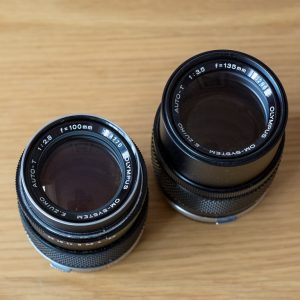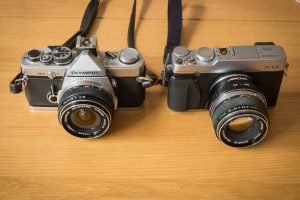The Way We Were – Part 2
Part 1 of this article can be found here.

“Silver nose” OM 100 f/2.8 (left) and later “black nose” OM 135 f/3.5. Taken on a Fuji X-E2 with OM 50 @f/5.6. Click on the thumbnail to see a larger version which shows how sharp the OM 50 renders.
Introduction
This is the second instalment of my article about using Olympus OM lenses on a Fuji X-E2 body. My purpose was twofold. The first was to see how older lenses compare to their modern counterparts and the other was to see how useful the X-E2’s manual focussing aids are. The camera has three options, focus peaking, a digital split image and just using the screen to focus. In all three modes, it is possible to magnify the central area of the image. This is not intended to be an objective test of the lenses, such assessments being available elsewhere on the Internet if needed. Rather, it is an account of using the lenses which date from a very different era on a modern digital camera.
Most of the lenses are at least 40 years old and are of the early “silver nose” type, so called because the front rim is silver. The exception is a later 135 f/3.5 acquired from my Dad which probably dates from the mid 80’s and has a more conventional “black nose” rim. The adapter was from K&F Concept and although inexpensive, appears to be well made with no problems mounting it on the camera or attaching lenses. Since the X-E2 has a crop sensor, it was not possible to evaluate the edge performance of the lenses which were designed for full frame.
Results
Most did well, apart from the 35 f/2.8 which was mediocre. I doubt if mine was a poor copy as the lens does not have a good reputation. All my test shots were taken in Raw and a liberal application of the Clarity control in Lightroom did manage to sharpen shots made with the 35 to an acceptable level. As might be expected a bit of extra contrast helped get the best out of all the lenses.
My favourite lens was always the amazingly compact 100 f/2.8 and this is still a good performer. The 24 f/2.8 also did well, albeit it was clearly outperformed by Fuji’s very sharp 27 f/2.8. Others who have used the OM 24 report it is soft towards the edges on full frame, although it improves when stopped down. In its day, the standard 50 f/1.8 did not get a good press, although the dealer R G Lewis (which recently ceased trading) reported that it was the sharpest it had ever tested. Wide open, it was distinctly soft, but was very sharp by f/4. In fact, it compared favourably with a couple of Leica lenses I tried.
One surprise turned out to be the 75-150 f/4 zoom, which I never really liked all those years ago. I even sent it back to Olympus to be checked. It was returned with just a minor adjustment. My test shots on film showed no major differences compared to the 100, but I simply did not take to the results. On digital, though, it turned in a respectable performance.
All of the Fuji’s focussing aids were useful, although focus peaking can be too optimistic and the resultant shimmering interfered with visual assessment. The split image needed a subject with distinct edges for the best result. Often, focussing with the electronic viewfinder and then magnifying the central portion to fine tune worked as well as either of the other two methods.
Surprising Conclusion
Will I use these lenses on anything more than an occasional basis? The answer is not one I initially expected. Being a two stage operation, manual focussing is less convenient than using autofocus. Neither is there anything special in the way that the lenses draw. The 18-55 kit zoom is versatile and the excellent results render the shorter Olympus lenses redundant. The OM 100 might fill in until (or if) I get a longer Fuji lens, but the 75-150 zoom has a useful range, especially on the crop sensor. Not only that, it fits in with my ambition to keep everything as compact and light as possible. On the face of it, a slowish, early telephoto zoom design lacking both autofocus and image stabilisation does not sound too promising. Maybe, though, this lens is finally due to get some love.

Olympus OM-2 (left) with the surprisingly compact OM 24 f/2.8 lens fitted. On the right is the Fuji X-E2 with a OM 50 f/1.8 attached via an adapter. Both cameras are similar in size with the Olympus lenses fitted, the X-E2 being slightly the larger of the two. Click on the thumbnail to see a larger version.